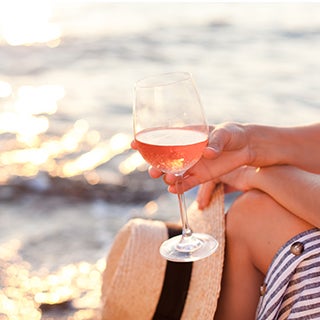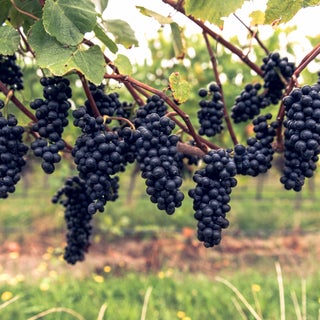Adventurous Aromatics & New Release Rose!
Food and wine, really is the perfect match! An almost symbiotic relationship that exists together to both parties’ mutual benefit. And just like with food – be it either style, ingredients or produce, wine can have a massive seasonal influence.

It’s an exciting time of year - the weather gets warmer, the days longer. You want to feel lighter in more than just what the scales tell you – what you consume becomes lighter too. The change in seasonal produce gives you a good kick in the backside on a gourmet front, bringing fresh clean flavours to the palate. Now, I’m not saying you need to shed your winter coat completely, after all I drink Champagne, Chardonnay and Syrah any day of the year, and long may that continue. But I do look forward to those fresher, more vibrant flavours, zingier acids and textural mouthfeel. As styles they are multi-dimensional, introducing more flavours and more matching opportunities … after all variety is the spice of life!
And it’s not just the food matching that makes for exciting times … it’s literally the calendar too, as many of these wines are made in New Zealand as early drinking styles. Like Sauvignon Blanc for instance. It may have been released a few months ago, but it has quite literally calmed down in the bottle and will never taste as good as it does right now!
And then the other styles that require more winemaking treatments and even some oak aging, are just being released! The real clincher – kismet some might say, is that with so much of the country on restricted duties right now, we’ve got plenty of time to do our research.
So, in the wise words of Pink – the singer, not the Rose... we better get this party started!
Aromatics.
Riesling, Gewurztraminer, Albarino, Pinot Gris, Sauvignon Blanc, Chenin Blanc, Verdelho and Muscat to name a few. We group this band of merry grapes differently as they are categorized by the flavours found in the grape naturally, opposed to more primary styles like Chardonnay where they are created with winemaking techniques such as oak aging, malolactic fermentation etc. If you ever get the chance to try a Gewurztraminer grape fresh from the vine, you’ll recognize it instantly as it tastes just like the finished wine.

Freshly picked Gewurztraminer grapes.
These beautiful fresh wines are referred to as aromatics due to their distinct floral aroma, caused by naturally occurring compounds called terpenes, specific to each varietal.
The aromatics as a group, offer fantastic variety. A heady perfume is not their only defining factor, with texture, acidity and natural sugars playing a big part in their DNA too. New Zealand has built a strong reputation for our aromatic wines, due in part to our well-suited cool climate. We can ripen fruit well during the day and preserve the precious acidity overnight when the temperature falls. This allows us to craft balanced wines, that aren’t always on the far end of the sweetness scale.
All these dimensions act as a flavour multiplier when matched with the right foods. Delightful on its own, but put Gewurztraminer with a spicy Southeast Asian dish and it becomes ‘next level’, and that’s what makes them so exciting!
Now broadly speaking these wines are made as early drinking styles to reflect their fresh and clean fruit flavours. But like every rule in wine, there are always exceptions and when it comes down to it, it’s all about personal preference. The point is to try as many styles as you can and decide which ones float your boat!
Generally speaking, varietals that have higher acid levels will last longer. Riesling, Viognier, Albarino and Chenin Blanc are all built to last but can be equally delicious when young. And varietals that have had more winemaking like barrel-aging or lees stirring will make for better lasting or more layered, complex styles. The vast majority of kiwi Sauvignon is fermented in stainless steel and bottled within a couple of months of harvest but travel to its French home in the Loire Valley where it is most commonly barrel-aged and you’ll find it often has a year or two of age on it!
To maximise your aromatic adventure, serve these wines chilled and in a traditional white wine glass. You want a narrow aperture, a slight tulip shape is ideal that funnels the aromas up to your nose, not something wide where they can escape out the sides.
Rosé

This pretty in pink wine has gone through one of the most incredible transformations in New Zealand winemaking history. Once upon a time it was only ever made when there was enough fruit available to satisfy a winemaker’s fancy. Restaurants would scramble to get a seasonal allocation that would only last a few months, then we’d all be on tenterhooks till the next vintage to see if another would be made.
Fast forward a decade or two and we’re drinking Rosé all year round. Hugely popular due to its crowd-pleasing approachability. Its taste profile sits smack in the middle of most palates for sweetness and acidity, making it not only easy drinking but incredibly versatile with a variety of foods.
Serious producers are dedicating entire vineyards to the varietals and clones of grapes suitable for the style they desire. And there’s a huge array of styles to shop from. The delicate soft pink hues of Provence with a hint of melon and strawberry, through to darker claret-like shades with weightier fruits like cherry and rhubarb.
Thankfully sweetness is negotiable these days. We can thank the French for that with the huge success of Provence Rosé introducing us to dry and refreshingly crisp flavours. However, don’t be alarmed by how sweet a Rose is described, as chilling can really mask this. Many people find the more unctuous styles incredibly memorable and are surprised that it might be sweetness adding to their appeal.
There are three ways to make Rosé.
- Maceration. The most common method, where the juice is left to rest on the skins for anywhere between two to twenty hours depending on the depth of colour desired.
- Blending. This method is used primarily in the production of sparkling rosé wines when a very small amount of finished red wine is added to white wine for colour.
- Saignée. Pronounced san-yay, it is a French term that translates as bleeding. This method refers to bleeding off a small amount of juice when making a dedicated red wine. It’s not often used but those wineries who specialize in the production of fine red wines may choose to make a Rosé that mirrors the intensity of their other red wines.
Rosé can be made using any red grape, although here in New Zealand Pinot Noir and Merlot are most common. Several of the imported wines featured this month also include Grenache, Syrah, Carignan, and Cinsault, as most Southern French wines are made using these varietals.
While we might be drinking this heady elixir all year round, it really does lend itself to the warmer months. Perfect for salads, seafood, charcuterie and cheese. Enjoy your Rosé with plenty of sunshine, well chilled and from a tulip-shaped, long-stemmed glass or a standard white wine glass. Once again, you want to funnel the aromas to your nose, don’t let them escape from a wide aperture glass.
Now is the perfect time to do your research on the latest new release Rosé. Try as many styles as you can to establish the flavours you like. Learn to verbalise those flavours and use our industry-leading Smart Search technology to find other wines with similar flavours.
Shop from our extensive range of top-quality rose wine or shop aromatics pinot gris



